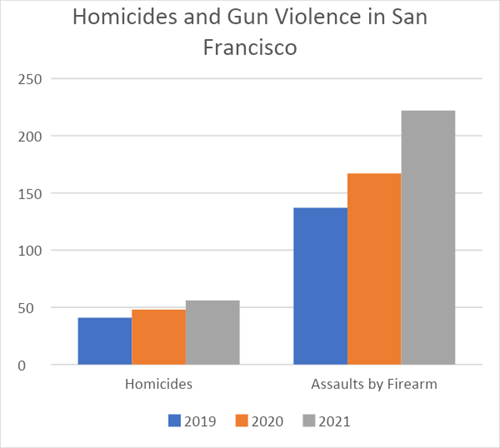The May 15th shooting at the Geneva Presbyterian Church in Laguna Hills, where six people were shot and one tragically died, is yet another reminder that California is experiencing an increase in homicides not seen since 1960.
Statewide, homicides were up 30 percent in 2020 and, while 2021 crime statistics will not be released until July 1, preliminary data from some cities indicate that 2021 will be another bad year for victims of crime. For example, in San Francisco there were 41 homicides in 2019, 48 in 2020, and 56 in 2021 and non-fatal shootings are far worse with 137 in 2019, 167 in 2020, and 222 in 2021, or a two year increase of 62 percent.
 In an effort to explain the rising toll, Gov. Gavin Newsom attributed the rise in homicides and gun crime in California to the increasing number of gun sales. He cited the 1.16 million firearms sold in California in 2020 as the chief cause.
In an effort to explain the rising toll, Gov. Gavin Newsom attributed the rise in homicides and gun crime in California to the increasing number of gun sales. He cited the 1.16 million firearms sold in California in 2020 as the chief cause.
Ironically, California is the most restrictive state for both firearms and ammunition purchases. Over 100 laws regulate the sale and transfer of firearms. California is also one of a small handful of states receiving an A grade from the Giffords Law Center.
Despite all of those laws, or perhaps because of them, in most crimes committed with firearms the firearms were obtained illegally.. According to the Bureau of Justice Statistics in 2016, 90 percent of firearms used in crimes were not obtained from a retail source. Only 1.3 percent of criminals bought their firearms legally from a retail source and less than 1 percent came from gun shows.
Put another way, 98 percent of firearms used by criminals were obtained illegally. The report goes on to state that 20 percent of criminals who possessed a firearm during the commission of a crime obtained it with the intent to use it during the crime.
And, perhaps the most telling statistic of all – 21 percent of all state inmates nationwide were armed during the commission of their crime.
According to reformers 40,000 California prison inmates are serving sentences that included a firearm enhancement. They used firearms that they stole or otherwise obtained illegally – then used them to threaten, injure, or kill. Today, members of the State Legislature are trying hard to overturn those enhancements.
Recently, the Assembly Public Safety Committee passed AB 1509 to eliminate the 10-20-25 year enhancements for the use of firearms in certain violent crimes including: Murder, rape, robbery, mayhem, and kidnapping. Those currently convicted under this law face enhanced sentences of 10 years for possession of a firearms, 20 years for discharging the firearm, and 25 for seriously injuring or killing someone.
AB 1509 would reduce the enhancement to just 1,2, or 3 years, respectively.
The Public Safety Committee voted 5-0 To move AB 1509 forward, although it died in the Appropriations Committee. Advocates vow to bring it back before the State Legislature.
While AB 1509 is a harbinger of things to come, SB 620 (2017) is already at work reversing statutes that successfully helped lower California’s crime rate and keep it low for nearly 30 years.
The measure was passed then on a partisan 22-14 vote to remove the firearms enhancement mandate and return discretion to judges to determine whether the firearms enhancement should be imposed. Their reasoning – the racial disparity in defendants facing firearms sentencing mandates.
Ironically, in 1976 Governor Jerry Brown signed sentencing reform legislation removing discretion from judges for precisely the opposite reason.
Judicial discretionary imposition of enhancements is difficult to track as there are no reporting requirements on the courts or California’s 58 District Attorneys to do so.
Concurrently, progressive District Attorneys in Los Angeles and San Francisco are refusing to charge enhancements – even if the case involves repeat violent offenders. They appear to be doing so because they believe California’s strict accountability and truth in sentencing laws are more unjust than the injuries inflicted on crime victims.
Legislators and policy makers might consider that the recent increase in violent crime has more to do with laws that fail to hold criminals accountable than the legal purchase of firearms.
Steve Smith is a senior fellow in urban studies at the Pacific Research Institute.

